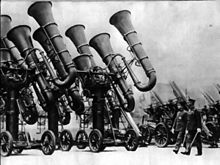Japanese war tuba
As a Japanese war tuba (from English Japanese War Tuba , Japanese 九 〇 式 大 空中 聴 音 機 , kyūjū-shiki dai kūchū chōonki , dt. "Type-90-large-celestial hearing apparatus") is a device for listening to the airspace.
history
In the middle of the First World War and with the advent of military aviation , research and development of devices for air surveillance began. One result of this research were devices for acoustic location, also called acoustic radar . These devices used the engine noise from aircraft for their passive detection.
With the development of radio wave radar in the mid-1930s, such acoustic locators became redundant.
Naming
Japanese war tuba is the slang term for an acoustic localizer used by the Imperial Japanese Army , which was visually very similar to a tuba . The name came about through a wrong or even joking interpretation of a photo from the 1930s. This picture shows the then Japanese Emperor Hirohito , some anti-aircraft guns , and the construction, consisting of several large horns that are pointed diagonally into the sky.
